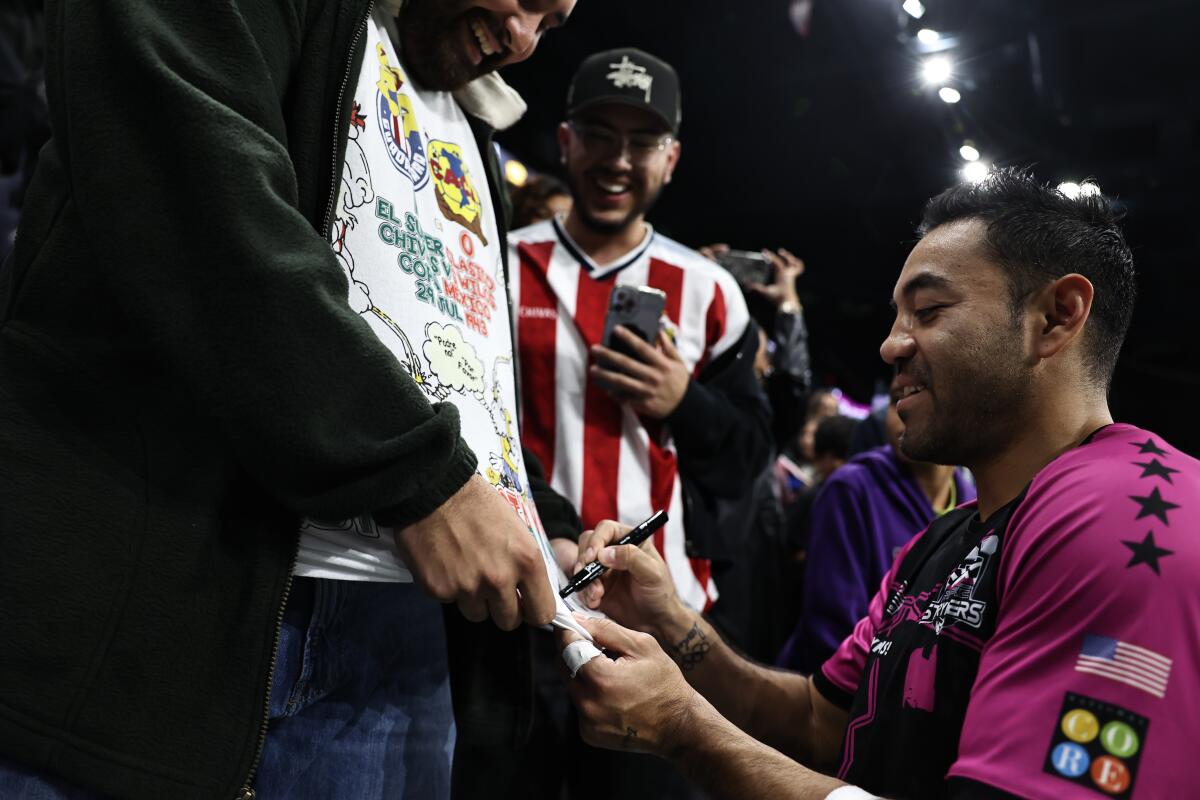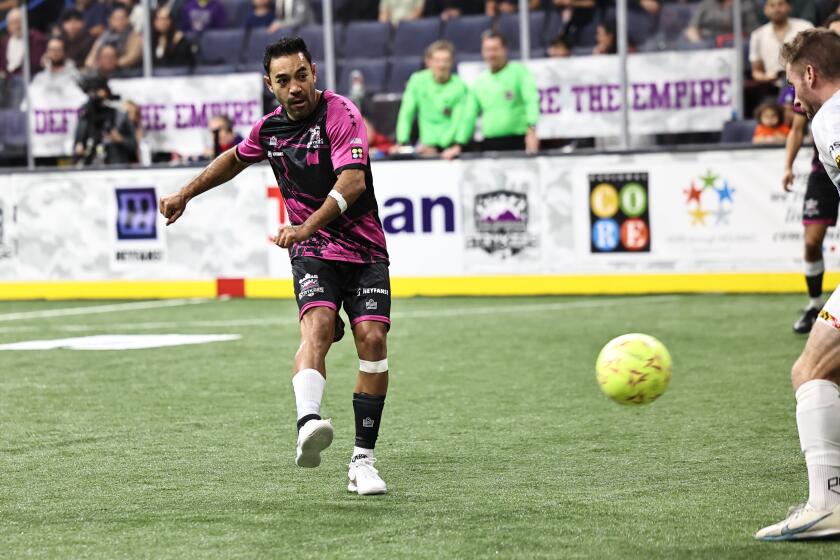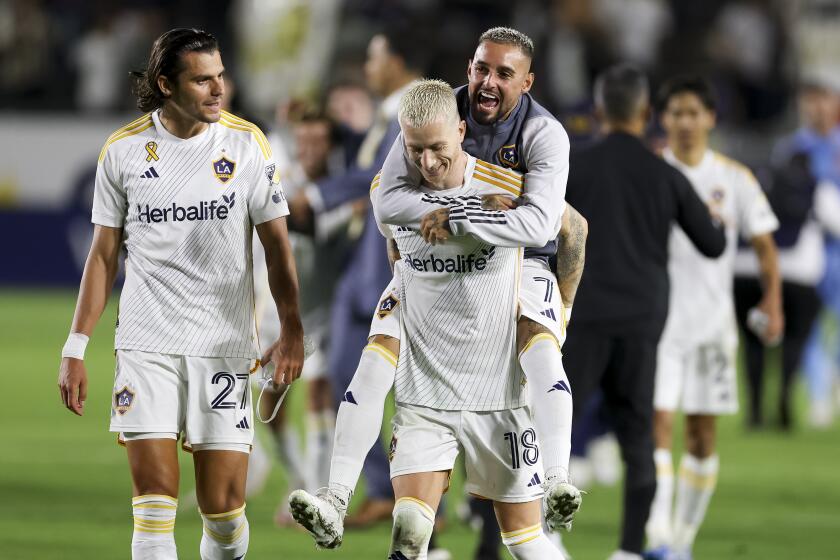Budding U.S. vs. Mexico indoor soccer rivalry will have different feel this year

- Share via
A few years back Jimmy Nordberg, then coach of an indoor soccer team in Ontario, was trying to come up with a way to build interest in a sport that, so far, had generated very little.
“So we thought, ‘What’s the best rivalry we have in this country as far as soccer goes?’” said Nordberg, now executive vice president of the Ontario-based Empire Strykers. “It’s us versus Mexico.”
That was five years ago and the idea worked so well, drawing 7,800 people that first year, nearly four times what Nordberg’s team averaged during the regular season, that the exhibition has become a regular staple of the team’s preseason schedule. This fall’s game, the fourth in a series that skipped two years because of COVID, will be played Sunday afternoon at the Toyota Arena in Ontario, with the men’s game following a women’s match.
It will also be very different than those that preceded it.
Marco Fabian is a two-time World Cup player for Mexico now playing arena soccer in Ontario, where the team owner hopes to grow the game with former outdoor stars.
Because of the work of Nordberg and Jeff Burum, the Strykers’ hyper-aggressive owner, the rosters of the two men’s teams, though largely made up of players from the Major Arena Soccer League, will also include World Cup veterans, former national team players and MLS Cup winners. It’s a bold and expensive step for the league and the club.
The Mexican side will have Marco Fabian, a member of two World Cup teams, Miguel Ponce, another former Mexican international, and reigning league most valuable player Genaro Castillo — provided Castillo’s visa is approved. Both Fabian and Ponce have played in the U.S.-Mexico rivalry outdoors, as has former U.S. international Brek Shea, who will play for the U.S. in the indoor game.
Shea, who also played in England and with five MLS teams before retiring in 2022, will be joined by Marcelo Sarvas, a two-time MLS Cup champion with the Galaxy who recently became a U.S. citizen. Sarvas, who turns 43 next month, played his final MLS game in 2017 but is in negotiations to join Fabian and Ponce with the Strykers when the MASL season begins in November.
“It’s like a routine again. Going to train, teammates, locker room,” Sarvas said. “It’s something that I did my entire life. It’s something that I love.”
Sarvas, who was let go as coach of the Galaxy’s MLS NextPro affiliate a year ago, said a friend brought him out to see some indoor games and he was quickly won over.
“It’s a good game,” he said. “It’s fast, it’s competitive. Always something is happening. I like the challenge of transitioning to indoor soccer.”
Shea got hooked in a similar way, playing in the seven-on-seven The Soccer Tournament (TST) in North Carolina the last two summers.
“That’s a fun tournament. I met quite a few guys that play indoor,” he said. “Had a great time with them, their style, their passion for the game. So the chance to play with them in their sport, I couldn’t turn it down.”
Eight of the 11 players the Galaxy started in Saturday’s El Tráfico win over LAFC weren’t with the team at the start of last season, and they’ve already won twice as many games.
MASL rules are slightly different that those in the TST — and massively different for the full-size outdoor game. Each side has five outfield players and a goalkeeper, and substitutions, which are unlimited, happen on the fly, with players tumbling off the bench and over the boards every 90 seconds on so. Games consist of four 15-minute periods, with the clock stopping for dead balls.
The walls are in play — and are frequently used to make passes that avoid defenders — while a blue card from the referee means two minutes in the penalty box, leaving one team to play shorthanded.
“There’s a lot of tricks with the wall, the speed of the game. You play two minutes and you’re out,” said Sarvas, whose play in the midfield was key to the Galaxy’s last two MLS titles. “There’s a lot of things that I need to learn but I’m willing to do it.”
The pay is different too. Sarvas was guaranteed $425,000 in his final MLS season with D.C. United in 2017. Salaries in the MASL typically range between $10,000 to $25,000 for the five-month season, which forces many players to supplement their income elsewhere. However the league has no salary cap so the Strykers and Burum, the freest-spending owner in the MASL, were able to give Fabian a two-year deal that included future rights to own a league franchise, making it potentially worth more than $1 million.
Shea, 34, has adopted a similar attitude about learning the game.
“It’s a smaller field, tighter spaces,” he said. “I’m probably going to be surprised by a few things but I fancy myself adapting pretty quick and I’m excited to give it a shot.”
The Los Angeles Kickers won multiple U.S. Open Cup titles in the 1950s and ‘60s. Players on those teams will be honored before Wednesday’s final.
Whether Sunday’s game is the end of Shea’s indoor career or, like Sarvas, the start of one, he wouldn’t say.
“Nothing’s off the table,” said Shea, who was guaranteed $206,100 in his final MLS season in 2022. “I want to give it a shot and Mexico has a soft spot in my heart. Who knows where it goes from there.”
Nordberg could say the same thing about the brainstorm he had five years ago. Last year the women’s game, which was streamed online, got 250,000 views in Canada and Mexico alone. This year the U.S. roster features dual national and Olympic medalist Lauren Sesselmann, who made 46 international appearances for Canada.
“Just continuing to grow the game, that’s what we’ve got to do,” he said. “We see the long-term goal. We see the effects. I don’t think there’s anybody that’s come to an indoor game that was a terrible time.
“People enjoy the product. We’ve just got to get people out there to see it.”








